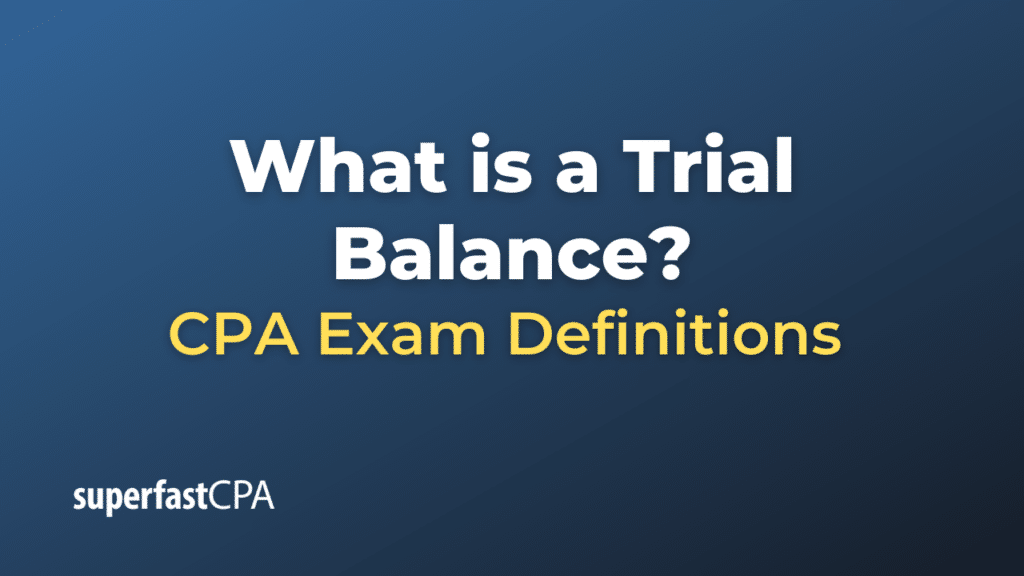Trial Balance
A trial balance is a bookkeeping or accounting worksheet in which all ledger accounts are listed in debit and credit columns. The purpose of a trial balance is to ensure that the total amount of debit balances in the general ledger equals the total amount of credit balances. This equality ensures that the double-entry accounting system has been maintained correctly and that there are no arithmetic errors.
A trial balance is typically prepared at the end of an accounting period and is a step in the accounting cycle leading up to the preparation of financial statements.
Structure of a Trial Balance:
- Account Name: This column lists the names of all general ledger accounts in the order they appear in the ledger — usually assets first, followed by liabilities, equity, revenue, and expenses.
- Debit (Dr): This column lists the total debit balance of each account.
- Credit (Cr): This column lists the total credit balance of each account.
The trial balance will have a total at the bottom of the debit and credit columns. In a correctly maintained system, the two totals should be equal.
Importance of a Trial Balance:
- Verification: It verifies the mathematical accuracy of the double-entry system. If debits equal credits, there’s a higher chance the books are accurate. However, this doesn’t guarantee that there are no errors. Transactions could still be posted to the wrong account or be recorded at incorrect amounts but still balance out.
- Foundation for Financial Statements: It serves as the base for preparing financial statements. The balances are used to draft the income statement, balance sheet, and, in some cases, the cash flow statement.
- Identification of Errors: If the debit and credit totals do not match, it’s a clear sign of an error which needs to be tracked down and corrected.
Limitations of a Trial Balance:
- Doesn’t Catch All Errors: As mentioned, just because a trial balance is balanced doesn’t mean there aren’t errors. Some mistakes, such as double posting or missing a transaction, won’t be caught by the trial balance.
- Not a Complete Representation: It doesn’t provide detailed insights into each account’s nature or provide a full picture of the company’s financial health — it’s merely a stepping stone to the more informative financial statements.
To sum up, while the trial balance is a useful tool in the accounting process, it’s essential to view it as one of many checks and balances that ensure the financial statements’ accuracy and reliability.
Example of a Trial Balance
Let’s use a simplified example to illustrate a trial balance. Imagine a small business named “Green Gardens” that has the following ledger accounts at the end of its first month of operations:
- Cash: $10,000 (Debit)
- Equipment: $5,000 (Debit)
- Supplies: $500 (Debit)
- Accounts Payable: $3,500 (Credit)
- Capital: $10,000 (Credit)
- Revenue from Sales: $3,000 (Credit)
- Wages Expense: $2,000 (Debit)
Given the above balances, the trial balance would look something like this:
Trial Balance of Green Gardens
As of [specific date at month-end]
| Account Name | Debit ($) | Credit ($) |
|---|---|---|
| Cash | 10,000 | |
| Equipment | 5,000 | |
| Supplies | 500 | |
| Accounts Payable | 3,500 | |
| Capital | 10,000 | |
| Revenue from Sales | 3,000 | |
| Wages Expense | 2,000 | |
| Totals | 17,500 | 16,500 |
The totals for the Debit and Credit columns do not match, which indicates there’s an error. Upon rechecking her work, the accountant realizes she forgot to record an expense:
- Rent Expense: $1,000 (Debit)
After adding this entry:
| Account Name | Debit ($) | Credit ($) |
|---|---|---|
| Cash | 10,000 | |
| Equipment | 5,000 | |
| Supplies | 500 | |
| Accounts Payable | 3,500 | |
| Capital | 10,000 | |
| Revenue from Sales | 3,000 | |
| Wages Expense | 2,000 | |
| Rent Expense | 1,000 | |
| Totals | 18,500 | 16,500 |
Clearly, something is still amiss. After further review, the accountant realizes she incorrectly recorded the capital. It should have been $12,000 instead of $10,000.
After correcting the Capital account:
| Account Name | Debit ($) | Credit ($) |
|---|---|---|
| Cash | 10,000 | |
| Equipment | 5,000 | |
| Supplies | 500 | |
| Accounts Payable | 3,500 | |
| Capital | 12,000 | |
| Revenue from Sales | 3,000 | |
| Wages Expense | 2,000 | |
| Rent Expense | 1,000 | |
| Totals | 18,500 | 18,500 |
Now, the trial balance is in balance with total debits equaling total credits.
This example illustrates how a trial balance can help in detecting errors in the bookkeeping process. If the totals don’t match, the accountant needs to investigate and correct the discrepancies.













